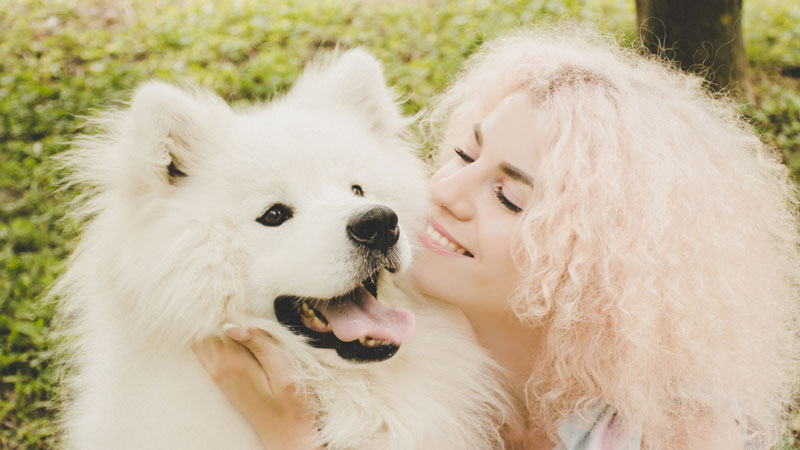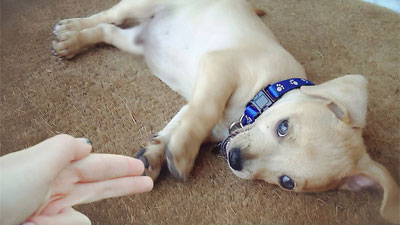- Size
- Smallest
- Small
- Small to Medium
- Medium
- Large
- Giant
- Characteristics
- Smartest
- Hypoallergenic
- Fluffy
- Best Guard
- Best Family
- Best for Kids
- Low Shedding
- Healthiest
- Police Dogs
- Most Calm
- Quietest
- Color
- White
- Black
- Grey
- Brown
- Blue
- Red
- Coat
- Hairless
- Short
- Long
- Origin
- Japan
- China
- Australia
- Germany
- Italy
- United States
- France
- Group
- Hound
- Terrier
- Herding
- Toy
- Working
- Sporting
5 Easy Steps: How to Teach a Dog to Smile

Photo by Valerie Elash on Unsplash
In the delightful realm of being a dog parent, where daily walks, vet visits, and nutritious meals become routine, there's a profound satisfaction that washes over you when you witness your furry friend flash a wide grin. The tongue peeking out, the teeth exposed – it's a sight that transforms stress into pure joy and happiness. But have you ever pondered the science behind your dog's smile or how to train your dog to smile on command?
In this article, we will explore the methods and considerations for training dogs to smile, unlocking another level of connection and happiness.
Do Dogs Smile? Decoding Canine Expressions
The saying goes, "There are hundreds of languages around the world, but a dog's smile speaks them all." While dogs may not laugh or smile in the same way humans do, their expressions, including panting, submissive grins, or even a muscle reflex, can be interpreted as a form of a "smile." Scientists have found evidence that suggests a dog's smile is more of a learned response than an instinctive one. Dogs have a natural tendency to imitate behaviors they observe, including the facial expressions of humans. Over years of interaction with humans, dogs have likely learned to mimic certain facial expressions, including smiling, as a way to communicate and bond with their human companions.
Additionally, the strong bond and social connection that dogs share with humans may further contribute to their learned response of smiling. Dogs are highly attuned to human emotions and seek to please their human companions. As they observe the positive response and interaction they receive when displaying a smile-like behavior, they are likely to repeat it, reinforcing the learned response.
How to Teach a Dog to Smile: A Step-by-Step Guide
Witnessing your dog perform a trick in front of an audience is undoubtedly a moment of pride for any dog owner. Teaching a dog to smile on command is a delightful endeavor but requires patience and a systematic approach. Let's explore the step-by-step process to get your dog to smile on cue:
Step 1: Prepare for Training
Before diving into training, gather the necessary supplies:
Treats: Use high-value treats that your dog loves and finds motivating.
Clicker (optional): A clicker can be a helpful tool to mark the desired behavior during training.
Quiet training area: Choose a quiet and calm space where your dog can focus without distractions.
Step 2: Capture the Natural Smile-Like Behavior
Start by observing your dog closely to identify moments when they displays a relaxed and happy facial expression that resembles a smile. This can be a subtle lifting of the lips or a slightly open mouth. As soon as you spot this natural smile-like behavior, use a clicker or a verbal cue (such as "Yes" or "Good") and immediately give your dog a treat. The purpose is to create a positive association between the behavior and the reward.
Repeat this process several times over multiple training sessions, consistently clicking and treating when your dog displays the natural smile-like behavior. Remember to be patient, as it may take some time for your dog to understand what behavior you're reinforcing.
Step 3: Shape the Behavior
Once your dog starts associating the natural smile-like behavior with the click or verbal cue, you can begin shaping it into a more pronounced smile. Here's how to do it:
Start by using a verbal cue: Choose a word or phrase like "smile" or "show me your teeth" to associate with the behavior. As your dog is displaying the natural smile-like behavior, say the cue just before clicking and treating. This will create an association between the cue and the behavior.
Raise your criteria: Gradually raise your criteria for the behavior. Only click and treat when your dog's mouth opens a bit more or the lips lift higher. This step-by-step approach helps shape the behavior towards a bigger, more pronounced smile.
Be patient and consistent: It's essential to stay patient and consistent throughout the training process. Reinforce the behavior each time, even if it's not a perfect smile yet. Gradually shape and reinforce smaller improvements until you achieve the desired behavior.
Step 4: Practice and Generalize
Once your dog is consistently displaying a smile-like behavior in response to the verbal cue, it's time to practice and generalize the behavior. Here's how:
Vary the environment: Practice the smiling behavior in different environments and locations. This will help your dog to generalize the behavior, meaning they can perform it in various situations, not just during training sessions.
Increase distractions: Introduce distractions gradually to test your dog's ability to maintain smiling behavior. Start with mild distractions, such as a toy or mild noises, and gradually increase the difficulty level over time.
Continue reinforcement: Even after your dog has mastered the smiling behavior, continue reinforcing it intermittently to maintain the learned behavior. This will prevent it from fading away over time.
Step 5: Enjoy the Smiles!
Once your dog has learned to smile on cue, you can show off their new trick to family and friends. Use verbal cue, such as "smile" or "show me your teeth," and reward your dog when they produce the desired behavior. This will create an association between the cue and the action, allowing you to showcase your dog's adorable smile on command.
Conclusion
Teaching your dog to smile on command is not merely about showcasing a delightful trick; it's a celebration of the profound connection between humans and their canine companions. Regardless of the reason behind your dog's smile – be it excitement, tiredness, or a state of relaxation – the warmth it brings to your heart is unparalleled.
As you embark on this training journey, filled with patience, positivity, and an understanding of your dog's emotions, you're not just teaching a trick; you're fostering a bond enriched with shared moments of joy. So, smile! You've embarked on a journey that transcends commands and treats, echoing the essence of a truly happy and harmonious relationship with your furry friend.
You May Also Like
 Dog Training TipsHow To Train Your Dog To Eye Contact
Dog Training TipsHow To Train Your Dog To Eye Contact Help & AdviceWhy Won't My Dog Learn To "Stand" Command?
Help & AdviceWhy Won't My Dog Learn To "Stand" Command? Dog Training TipsThe 'Stand' Command: A Crucial Yet Overlooked Training Cue
Dog Training TipsThe 'Stand' Command: A Crucial Yet Overlooked Training Cue Dog Training TipsThe Place Command: Teach Your Dog to Go to Their Place
Dog Training TipsThe Place Command: Teach Your Dog to Go to Their Place Dog Training TipsDog Tricks: Teach Your Dog to High Five
Dog Training TipsDog Tricks: Teach Your Dog to High Five Dog Training TipsTrain Your Dog to Play Dead: A Step-by-Step Guide
Dog Training TipsTrain Your Dog to Play Dead: A Step-by-Step Guide